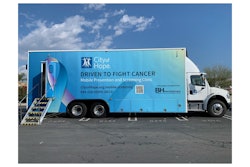Radiology departments receiving more research funding from the National Institutes of Health (NIH) are less likely to serve marginalized populations, a study published January 23 in Radiology found.
A team led by Antonio Lopez from Drexel University in Philadelphia found a negative correlation between the amount of radiology department research funding received and institutional rankings for serving patients from racial and/or ethnic minority backgrounds, as well as patients with low income and lower education levels.
“Incentives to promote collaboration between well-funded large academic institutions and institutions with a focus on providing equitable care to underserved groups may be required to improve research inclusion,” the Lopez team wrote.
Previous reports have documented healthcare access disparities and lack of inclusion in clinical research regarding historically underserved populations. However, the researchers pointed out a lack of data analyzing research funding of institutions that serve historically underserved groups.
Lopez and co-authors studied the relationship between NIH research funding awarded to radiology departments and Lown Institute Hospitals Index rankings for inclusivity and community benefit.
The index measures the social responsibility of more than 3,600 hospitals across the U.S. It evaluates hospitals on more than 50 metrics across equity, value, and outcomes. Among these metrics is the community benefit metric, which measures charity care spending, Medicaid as a proportion of patient revenue, and other community benefit spending.
The researchers included funding data collected between 2017 and 2021 from 75 U.S.-based radiology departments. These departments were awarded NIH funding ranging from $195,000 to $216.8 million.
The team used Pearson correlation coefficients, represented by r values, with a value of 0 serving as the reference point. It reported a negative correlation between NIH funding received and departments serving marginalized populations. These included r values of -0.34 for patients from racial/ethnic minority backgrounds, -0.44 for patients with low income, and -0.46 for patients with lower education levels (p < 0.001 for all).
Additionally, the researchers found no correlations between the amount of research funding received and parts of the community benefit metric for the Lown Institute Hospitals Index. These included r values of -0.19 for charity care spending (p = 0.06), -0.04 for community investment (p = 0.68), and -0.10 for patient revenue (p = 0.22).
The study authors highlighted that their results are in line with other studies measuring NIH funding disparities at the institutional level. Previous reports indicate that patients from historically underserved groups are more likely to seek care at under-resourced or largely minority-serving hospitals. These institutions are usually not associated with major, well-funded research centers, the authors wrote.
The authors also highlighted that options exist for addressing these barriers to patient care. These include establishing cross-institutional collaborations between research institutions and safety net and minority-serving hospitals, such as the Minority-Based Community Clinical Oncology Program of the National Cancer Institute. The team added that efforts by radiologic societies such as the American College of Radiology Imaging Network and the Clinically Oriented Academic Radiology Department Research Initiative could support such efforts.
In an accompanying editorial, Tejas Mehta, MD, and Max Rosen, MD, from the University of Massachusetts echoed that sentiment, writing that relationships between academic medical centers and community hospitals and other members should be strengthened.
“Having an infrastructure where communications and collaboration between the academic medical centers and affiliated community hospitals as routine and seamless is paramount,” they wrote. “Including community members as advisors and collaborators can also help disseminate important health information to other community members who use the hospitals.”
The full study can be found here.



















